

Catch Fish with
Mike Ladle
Information Page
SEA FISHING
For anyone unfamiliar with the site always check the FRESHWATER, SALTWATER and TACK-TICS pages. The Saltwater page now extends back as a record of over several years of (mostly) sea fishing and may be a useful guide as to when to fish. The Freshwater stuff is also up to date now. I keep adding to both. These pages are effectively my diary and the latest will usually be about fishing in the previous day or two. As you see I also add the odd piece from my friends and correspondents if I've not been doing much. The Tactics pages which are chiefly 'how I do it' plus a bit of science are also updated regularly and (I think) worth a read (the earlier ones are mostly tackle and 'how to do it' stuff).
Catching Sea fish.
Why add bait to a lure?
Certain species of fish take artificial lures, and there are good reasons why they do. Most obvious is probably the fact that they are fiercely predatory; the lure looks and moves more or less like the things they eat, so they try to catch it and devour it. This is clearly the case with out-and-out predators such as pike, tigerfish or barracuda, which have large mouths and sharp teeth designed to trap, injure and hold fast moving, slippery prey. There are other, equally predatory, species like bass, perch, mackerel, tarpon and snook, which have gripping tooth pads or fine, hacksaw-type teeth that are extremely effective. If we set out to catch any of these predators our aim is to make the lure resemble a fish, squid or other regular item of diet. Preferably, the lure should seem isolated from the protective cover of shoalmates and slightly injured - in other words it ought to look like - an easy meal.
The 'needle' teeth of a pike - not much chance of escape.
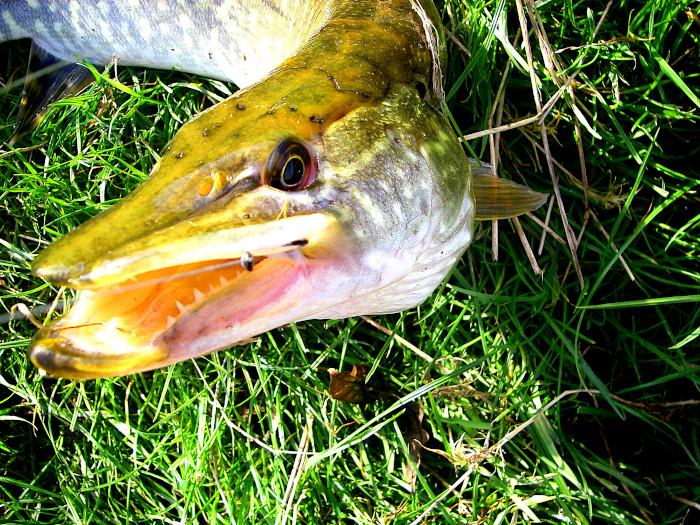
The friction pad jaws of a perch - equally effective!
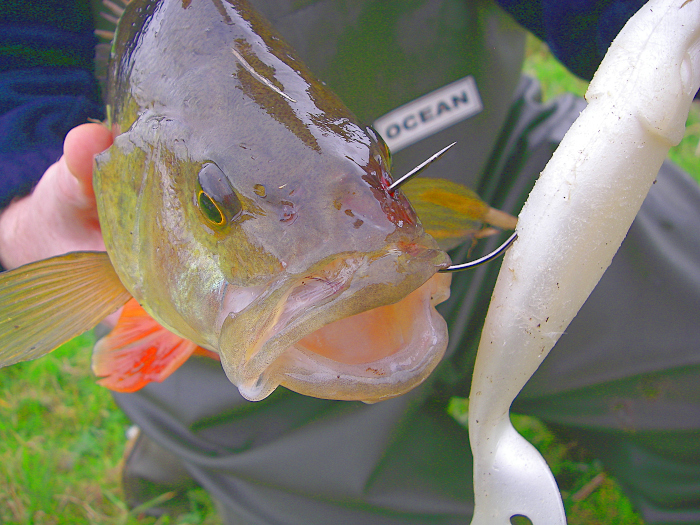
A second possibility is that the lure-taker is an omnivore. A good example is the chub, which likes a bit of meat with its veg. In fact many fish seem to enjoy a spot of animal protein if it presents itself in the right shape and form. Another reason why fish attack lures is territorial defence. Species such as wrasse or black bream seem to be trying to defend their feeding patch or nesting area from other fish; to do this they chase and bite at the supposed invader or competitor to injure it or drive it away. In all these cases the addition of bait to a lure may simply provide a target to make the lure a little more attractive. Nowadays it is commonplace to add bait to lures, presuming that the added 'authentic' scent may give an additional incentive to the taking fish. Boat anglers fishing for ling, cod or other big predators will bait their pirks with strips of squid or fish with this in mind.
A nice chub on a small Mepps lure - did it think it was a minnow?
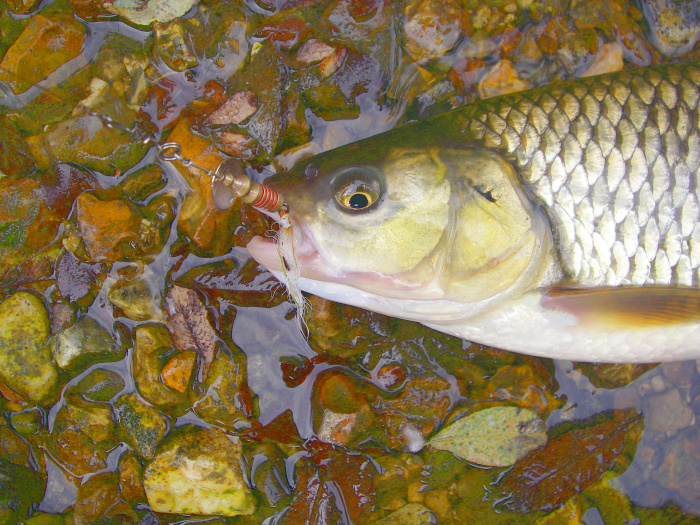
A ballan wrasse on a lure - was it trying to guard it's favourite spot?
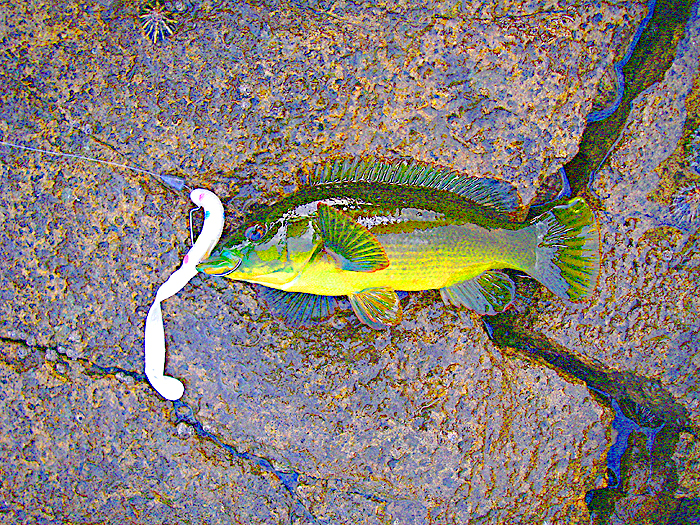
Now we get to the real principle of the baited spinner. We can dismiss the fish I've already mentioned because they will all take unbaited lures, although the addition of bait may induce more bites . Many other species can probably be regarded as 'accidental' captures (most coarse fish for example) which would take baits more readily if they were not trailing behind a flashing spoon. Last time I totted up how many species of fish I have caught on baited lures it was over twenty. To be honest I've been doing it for so many years that I have now forgotten exactly what, when or how many of each there have been. Among the captures have been dace, roach, bream, rudd, perch, pike, grayling, trout, wrasse, bass, thick- and thinlipped mullet, pouting, black bream, pollack, plaice, mackerel and several others. The real crunch comes in deciding which of these fish might actually take baits BETTER with the addition of some sort of attractor?
Presumably the idea of this 'baited lure' approach is to attract the fish with the artificial and then to induce them to bite by giving them something edible. The first person to write seriously about using baited lures, from the standpoint of actual experience, was J.P Garrad in his articles and then in his much misquoted book 'Sea Angling with the Baited Spoon'. Garrad's 'experiments', in which he trolled and drifted the gear from a rowing dinghy using both baited and unbaited lures, showed that it was actually possible to select for the species which you wanted to catch simply by the way you rigged and fished a lure. Flounders, eels and bass were his main quarry and they were all present in numbers where he fished. Remarkeably, he was able to pick out which of the three he wanted (on identical ragworm baits) simply by slightly changing his tactics. Even more impressive was the fact that he could also select the size of flounders which he caught, chiefly by changing the size of the spoon.
Flounders take ragworm baits keenly, with or without the embellishment of spoons.
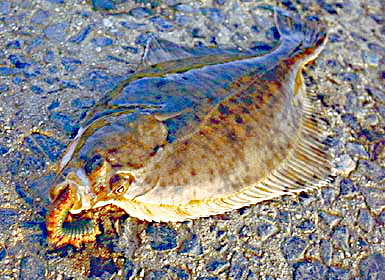
Grandson Ben (years ago) with an eel caught on bait. Who'd have thought they'd take a baited spoon?
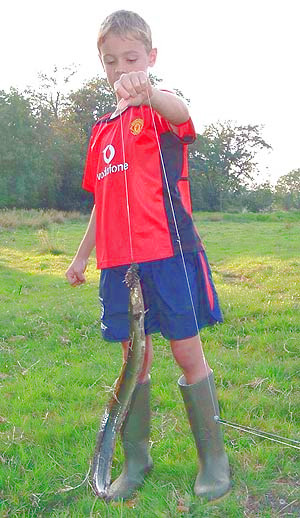
A schoolie taken on a ragworm baited lure.
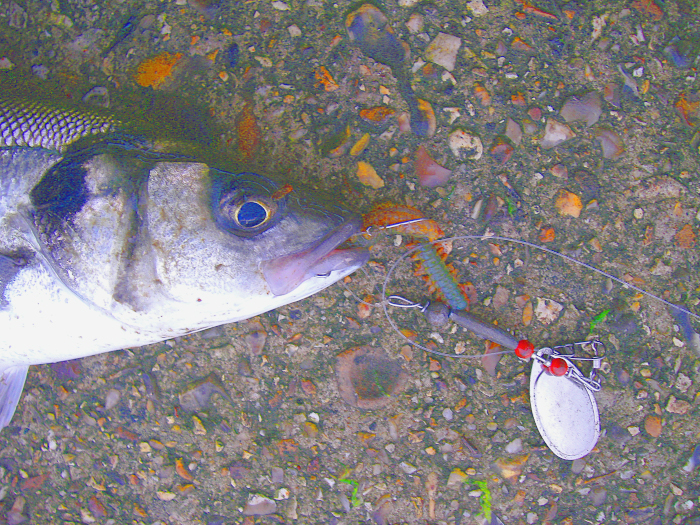
Later on French anglers also began to use ragworm baited spinners, but in this case they were specifically to catch thinlipped mullet. Like Garrad's flounders, the mullet seem to be attempting to rob other fish of their meals (a bit like frigate birds robbing smaller seabirds of their catch). The baited spinner tactic was then re-introduced to Britain by anglers fishing for mullet at Christchurch. The use of this method was, thereafter, more or less restricted to the estuary at Christchurch until we extended and used it, with great success, in a number of other south-coast rivers.
Returning to the so-called 'flounder spoons', these devices are now commonly sold in tackle shops. However, I have NEVER seen one for sale which even remotely resembled the deadly design which Garrad painstakingly evolved. It is a fact that flounders (and some other fish) can be attracted to almost any moving object. Nevertheless, attaching a string of beads, a lump of coloured plastic or a piece of metal in front of a baited hook and dumping it on the sea bed (as many plaice anglers do these days with apparent success) does not even approach the benefits to be gained by fishing a proper baited spoon.
According to Garrad, a successful and effective flounder spoon should - Firstly, be large (8-10cm or more long and quite wide - a bit like a dessert spoon) it may also be painted white. Secondly, the hook attachment should be to the front end of the spoon only. Thirdly, the baited hook must not spin so a chain of swivels is required to join it to the spoon. In using these spoons for flounders they should be trolled with the flow to give the fish sufficient time to home in and take the bait.In Garrad's day the crudeness of tackle and poor casting capability, prevented the effective use by anglers fishing from the shore. In fact he was rather scathing about the possibility of casting and retrieving these lures from the shore, considering that the retrieve was never long enough to allow the flounders to mouth and take the bait. This may no longer be the case.
What he did show was that the size of spoon and way it is fished is ABSOLUTELY CRITICAL. However, it is a fact that even with modern tackle big, cumbersome, flounder spoons are not the easiest things to operate for the land-based angler. Some years ago I tried casting smaller versions (my mullet spoons) from the beach and caught (as Garrad would have predicted) quite a few small flounders, while beach casters using conventional bottom tackle went fishless. If you are interested in the details, it is well worth getting hold of a second-hand or library copy of Garrad's book and trying to make your own versions.
Spinning for flounders from a sandy beach.
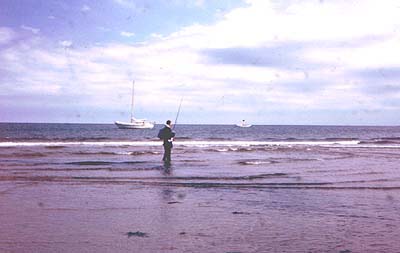
A small flounder caught from the beach on a rag baited 'mullet' spoon.
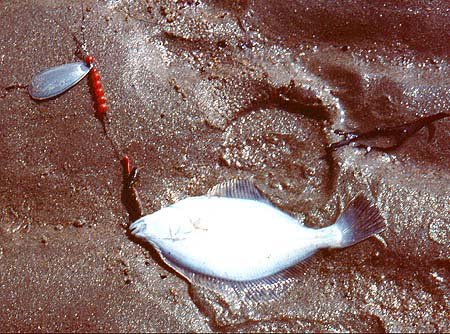
... and another one on the same set up.
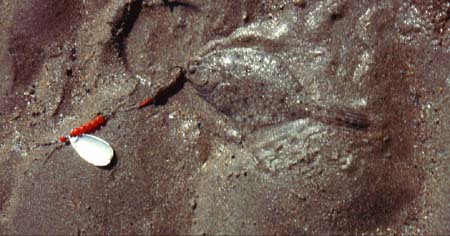
As I've already suggested the fish which seem to be tailor made for the use of baited spoons (=spinners) are thin lipped mullet. The close resemblance between these fish and their thick lipped relatives is misleading; because while thicklips will occasionally take ragworm baited spinners, thinlips often go mad for them.
If you try it, the first thing to note is how the fish react to the lures. A shoal of thinlips can be minding their own business, grovelling away on the river bed. You cast your lure out and retrieve it past the shoal. No interest! Do it again and then again and one of the fish looks up from its mud sifting and follows the spinning blade for a short distance. A couple more casts and the entire shoal is rushing after your lure, jostling to get at the bait.
Big thinlips feeding in freshwater, miles from the sea.
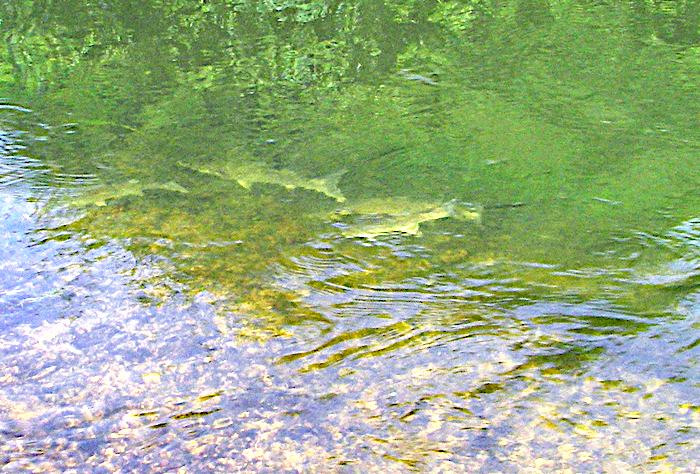
If you watch carefully you can see an individual fish following just behind the trailing ragworm and vibrating its lips, presumably to sense the chemical signals which are being released. The fish may take the worm in its mouth and apparently suck at it giving a nudge on the rod tip. Two or three times you may feel similar taps on the rod then suddenly the fish turns away and the rod bends to its weight as it hooks itself.
The smooth and sensitive mouth of the thinlip.
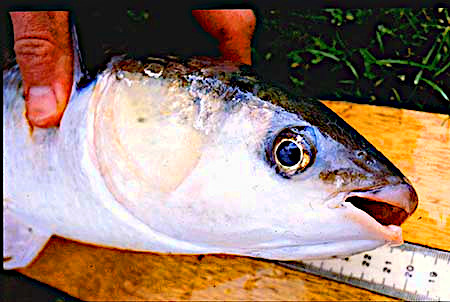
Ragworm is effective in freshwater but should be changed every few casts.
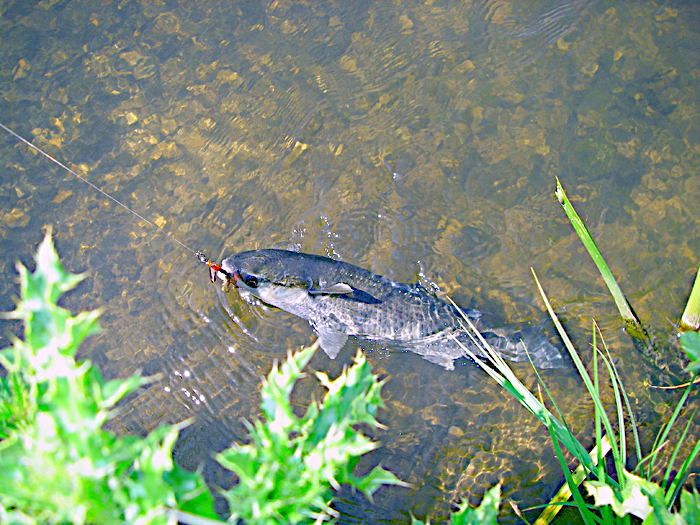
When the mullet are close to the spoon, because of the position of their eyes, it seems unlikely that they can see the ragworm. Consequently it is a good idea if the worm trails out straight behind. Secondly, because the mullet 'suck' at the end of the worm it is best to have a hook positioned right at the back end of the bait. It is often effective to reel as slowly as possible, letting the lure hang in the current although at times you can reel at high speed with or across the flow and the fish will bow-wave after the fast moving spinner before taking.
Sometimes the fish are suicidal and you can catch one a chuck. On other occasions they are distinctly fussy and you will get countless unhookable knocks. Whatever you do DON'T strike. The fish will hook themselves if your hooks are sharp and correctly positioned.
A nice mullet, unhooked and ready to go back.
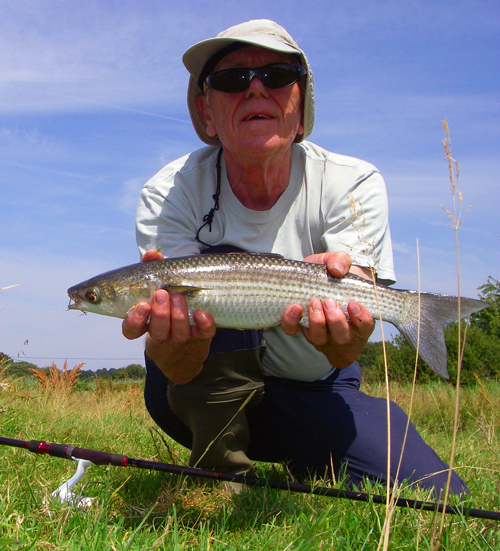
Thinlips, like most other grey mullets are true sea fish, but they tolerate freshwater well and, particularly in Spring and Autumn, they enter rivers to feed on blooms of algae. They can also be caught in large numbers in estuaries and river mouths. Their thicklipped cousins, which grow a fair bit larger, will also take baited lures but in my experience they are much less inclined to do so.
If you have any comments or questions about fish, methods, tactics or 'what have you.'get in touch with me by sending an E-MAIL to - docladle@hotmail.com
– PLEASE TELL YOUR TWITTER, FACEBOOK, EMAIL FRIENDS ABOUT THESE BOOKS.
NEW BOOK
"Fishing for Ghosts - Successful Mullet Angling"
written with David Rigden IT'S AVAILABLE FROM -ALSO THE NEW BOOK
“The Second Wave”
Written with Steve Pitts this is a SEQUEL TO THE BESTSELLER "Operation Sea Angler" IT'S AVAILABLE ON PAPER OR FOR YOUR KINDLE FROM -